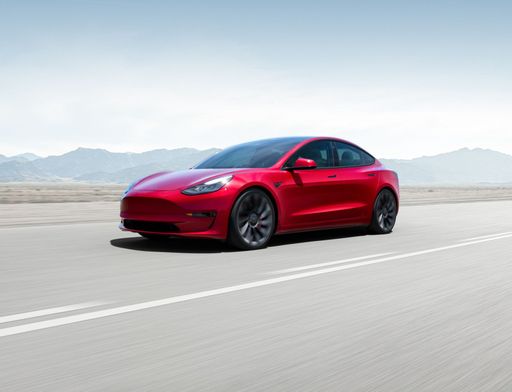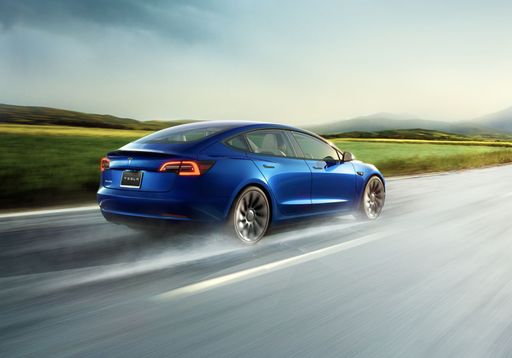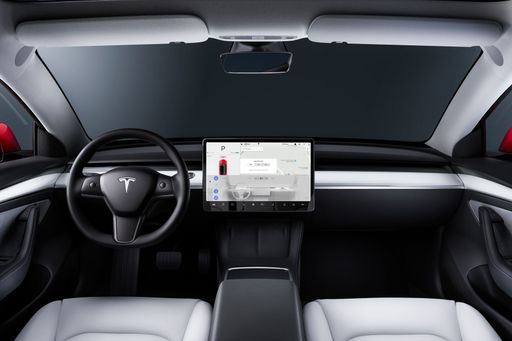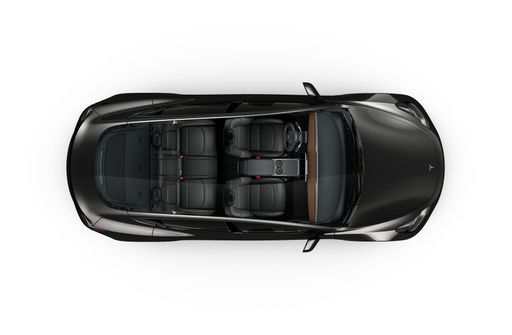Isuzu D-Max vs Tesla Model 3 – Differences & prices compared
Compare performance, boot space, consumption and price in one view.
Find out now: which car is the better choice for you – Isuzu D-Max or Tesla Model 3?
The Isuzu D-Max (Pickup) comes with a Diesel engine and Automatic transmission. In comparison, the Tesla Model 3 (Hatchback) features a Electric engine with Automatic transmission.
When it comes to boot capacity, the Isuzu D-Max offers , while the Tesla Model 3 provides 594 L – depending on how much space you need. If you’re looking for more power, decide whether the 163 HP of the Isuzu D-Max or the 627 HP of the Tesla Model 3 suits your needs better.
In terms of consumption, the values are 8.70 L per 100 km for the Isuzu D-Max, and 13.20 kWh for the Tesla Model 3.
Price-wise, the Isuzu D-Max starts at 34300 £, while the Tesla Model 3 is available from 34300 £. Compare all the details and find out which model fits your lifestyle best!
Isuzu D-Max
The Isuzu D-Max stands out in the pickup truck market with its robust design and impressive durability, making it a reliable choice for both work and leisure. Its interior blends practicality with a touch of comfort, featuring user-friendly technology that enhances the driving experience. This vehicle's off-road capabilities and strong performance make it a versatile companion for tackling a variety of terrains.
detailsTesla Model 3
The Tesla Model 3 stands out in the electric vehicle market with its sleek design and impressive performance capabilities. It offers a seamless driving experience that combines advanced technology with minimalistic interiors, creating a futuristic feel on the road. Additionally, its range and charging infrastructure make it a practical choice for both city commuting and longer journeys.
details @ tesla.com
@ tesla.com
 @ tesla.com
@ tesla.com
 @ tesla.com
@ tesla.com
 @ tesla.com
@ tesla.com

|
|
|
|
|
Costs and Consumption |
|
|---|---|
|
Price
34300 - 50100 £
|
Price
34300 - 50100 £
|
|
Consumption L/100km
8.7 - 9 L
|
Consumption L/100km
-
|
|
Consumption kWh/100km
-
|
Consumption kWh/100km
13.2 - 16.7 kWh
|
|
Electric Range
-
|
Electric Range
513 - 702 km
|
|
Battery Capacity
-
|
Battery Capacity
62 - 79 kWh
|
|
co2
228 - 235 g/km
|
co2
0 g/km
|
|
Fuel tank capacity
76 L
|
Fuel tank capacity
-
|
Dimensions and Body |
|
|---|---|
|
Body Type
Pickup
|
Body Type
Hatchback
|
|
Seats
2 - 5
|
Seats
5
|
|
Doors
2 - 4
|
Doors
5
|
|
Curb weight
1905 - 2110 kg
|
Curb weight
1822 - 1929 kg
|
|
Trunk capacity
-
|
Trunk capacity
594 L
|
|
Length
5280 - 5320 mm
|
Length
4720 - 4724 mm
|
|
Width
1810 - 1870 mm
|
Width
1850 mm
|
|
Height
1770 - 1790 mm
|
Height
1431 - 1440 mm
|
|
Payload
990 - 1095 kg
|
Payload
303 - 333 kg
|
Engine and Performance |
|
|---|---|
|
Engine Type
Diesel
|
Engine Type
Electric
|
|
Transmission
Automatic
|
Transmission
Automatic
|
|
Transmission Detail
Automatic Gearbox
|
Transmission Detail
-
|
|
Drive Type
All-Wheel Drive
|
Drive Type
Rear-Wheel Drive, All-Wheel Drive
|
|
Power HP
163 HP
|
Power HP
283 - 627 HP
|
|
Acceleration 0-100km/h
12.60 s
|
Acceleration 0-100km/h
3.1 - 6.1 s
|
|
Max Speed
180 km/h
|
Max Speed
201 - 262 km/h
|
|
Torque
360 Nm
|
Torque
420 - 660 Nm
|
|
Number of Cylinders
4
|
Number of Cylinders
-
|
|
Power kW
120 kW
|
Power kW
208 - 461 kW
|
|
Engine capacity
1898 cm3
|
Engine capacity
-
|
General |
|
|---|---|
|
Model Year
2024 - 2025
|
Model Year
2023 - 2024
|
|
CO2 Efficiency Class
G
|
CO2 Efficiency Class
A
|
|
Brand
Isuzu
|
Brand
Tesla
|
Isuzu D-Max
The Powerhouse on Wheels: An Overview of the Isuzu D-Max
When it comes to robust and reliable pick-up trucks, the Isuzu D-Max stands out as a formidable contender. With its range of versatile models and a reputation for toughness, the D-Max caters to the needs of both commercial users and off-road adventurers. This article delves into the technical details and innovative features that make the Isuzu D-Max a leader in its class.
Under the Bonnet: Performance and Specifications
At the heart of the Isuzu D-Max lies a 1.9-litre turbocharged diesel engine, producing a power output of 163 PS (120 kW) and a torque of 360 Nm. This robust engine is paired with either a six-speed manual or a six-speed automatic transmission, offering flexibility and control for diverse driving conditions. With a top speed of 180 km/h, the D-Max balances power and performance, making it well-suited for both urban environments and rugged terrains.
Efficiency and Eco-Standards
Fuel efficiency is a pivotal factor for many buyers, and the Isuzu D-Max delivers with a consumption ranging from 8.1 to 9.2 L/100km. Despite its impressive capabilities, the D-Max falls into CO2 efficiency class G, with emissions between 212 and 241 g/km. While this places it towards the higher end of the emissions spectrum, its efficiency is commendable considering its size and power.
Innovative Features and Driver Comfort
Isuzu has integrated numerous innovative features in the D-Max, enhancing both functionality and driver comfort. The pick-up is available in several configurations, including single, space, and double cab options with seating arrangements for 2 to 5 passengers. Equipped with state-of-the-art safety technologies and infotainment systems, the D-Max ensures a comfortable and secure ride. Various trim levels, from L 2WD to V-Cross 4WD Automatik, provide options for different preferences and requirements.
Design and Dimensions
The Isuzu D-Max's design is as practical as it is imposing. Measuring between 5270 mm to 5310 mm in length and 1810 mm to 1870 mm in width, with a height of 1770 mm to 1790 mm, it offers a commanding road presence. Its substantial payload capacity ranges from 995 kg to an impressive 1130 kg, making it an ideal choice for heavy-duty operations.
Pricing and Market Position
The Isuzu D-Max is competitively priced within the range of 35,765€ to 56,765€, illustrating its value proposition in the pick-up truck market. It caters to varied customer needs with an extensive line-up and competitive pricing, thereby solidifying its position as a top choice for those seeking a reliable and durable pick-up.
Conclusion: A Vehicle Built for Versatility
The Isuzu D-Max is more than just a workhorse; it is a testament to engineering capable of blending power, practicality, and innovation. Its enduring appeal lies in its versatility and robust performance, making it a popular choice across different demographics and industries.
Tesla Model 3
Introduction to the Tesla Model 3
The Tesla Model 3 has quickly become a beacon of innovation in the world of electric vehicles (EVs), embodying a perfect blend of performance, technology, and sustainability. Known for redefining the electric car experience, the Model 3 stands as a testament to Tesla's commitment to pushing the boundaries of automotive design and engineering.
Design and Build
With its sleek fastback silhouette, the Tesla Model 3 is not only visually captivating but also aerodynamically efficient. Measuring at 4720 mm in length, 1850 mm in width, and 1441 mm in height, it optimally combines aesthetics with functionality. The Model 3 boasts a 594-litre boot space, offering ample room for everyday storage needs. Built with environmental efficiency in mind, its CO2 efficiency rating stands proudly at a perfect A, making it an ideal choice for the eco-conscious driver.
Powertrain and Performance
Under the bonnet, the Model 3 offers a diverse range of powertrains. It is available in both rear-wheel drive (RWD) and all-wheel drive (AWD) options, catering to different driving preferences. The electric motors deliver a remarkable power output ranging from 283 to 460 PS, translating to 208 to 338 kW. Depending on the variant, the Model 3 can accelerate from 0 to 100 km/h in a staggering 3.1 to 6.1 seconds. With a top speed between 201 and 262 km/h, the Model 3 promises an exhilarating driving experience.
Battery and Range
The Model 3 is equipped with a robust battery pack, available in capacities ranging from 62 to 79 kWh. This ensures an impressive electric range of 513 to 629 km on a single charge, catering perfectly to both city drivers and those who frequently embark on long-distance journeys. The energy consumption is between 13.2 to 16.5 kWh per 100 km, showcasing Tesla's efficiency in engineering cutting-edge EV technology.
Technological Innovations
The interior of the Model 3 is where technology takes centre stage. With its state-of-the-art autopilot feature, semi-autonomous driving is not just a promise but a reality. The vehicle continually updates over-the-air, ensuring that the software is always up-to-date with the latest features and improvements. Furthermore, the minimalist interior design, accentuated by a massive central touchscreen display, epitomises modernity and enhances the user experience with intuitive controls and navigation.
Cost Considerations
Given its advanced features and performance capabilities, the Model 3's price point ranges from €42,490 to €58,490. Monthly operating costs are estimated to be between €1,073 and €1,397, with per-kilometre costs between 42.9 and 55.9 cents, making it a competitively priced option within the premium EV market segment.
Conclusion
The Tesla Model 3 continues to lead the charge in the electric revolution, offering a compelling package of performance, innovation, and sustainability. For anyone seeking a modern, efficient, and technologically advanced vehicle, the Model 3 deserves serious consideration. With Tesla's groundbreaking vision and innovative engineering, this vehicle is not merely an investment in cutting-edge technology but also in a sustainable future.
Which drive types are available for the Isuzu D-Max?
Available as All-Wheel Drive.
The prices and data displayed are estimates based on German list prices and may vary by country. This information is not legally binding.
